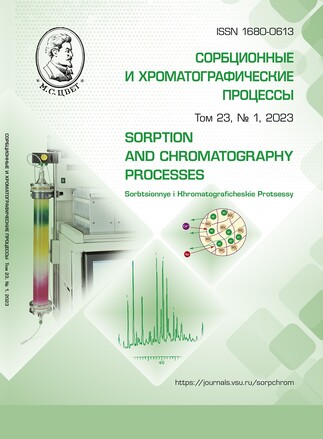Silver-containing Nanocomposite based on aqueous dispersion of reticulated poly-N-vinylcaprolactam
Abstract
Metal-containing polymer nanocomposites have specific functional properties, determined by the nature of the polymer carrier and metal. In this study we investigated the conditions of the immobilization of a reticulated poly-N-vinylcaprolactam stabilized by a hydrophobically modified polyacrylamide of biologically active silver nanoparticles in an aqueous colloidal dispersion.
Synthesis of an aggregative stable aqueous dispersion of a reticulated poly-N-vinyl caprolactam was carried out by precipitation heterophase radical polymerization. The spherical shape and nanosize of the synthesized particles were confirmed by transmission electron microscopy and dynamic light scattering. The interaction of hydrophobically modified polyacrylamide and reticulated poly-N-vinylcaprolactam stabilized by this polymeric surfactant was characterized by IR spectroscopy. The appearance of amide groups and carboxyl groups was found, and the formation of supramolecular structures was suggested.
The synthesis of a silver-containing nanocomposite based on a polymer dispersion was carried out by chemical reduction of silver ions adsorbed on polymer particles using various reducing agents. It was found that the introduction of silver ions into the polymer dispersion does not cause its coagulation. Factors of a non-electrical nature act along with the ionic-electrostatic stability factor provided by amino groups partially hydrolyzed to carboxyl groups in surface-active polyacrylamide.
The interaction of silver ions with a polymer carrier was revealed using the UV spectroscopy. Using dynamic light scattering and transmission electron microscopy, it was found that the binding of silver ions to a polymer matrix leads to a decrease in the size of polymer particles while their shape was maintained, as well as an increase in the fraction of nanometer-sized particles. The conducted studies allowed to conclude that silver ions are retained on the surface of polymer particles due to ion-exchange and specific adsorption, and the next stage is the reduction of Ag+ ions into the metallic Ag0 takes place in the polymer matrix.
Sodium borohydride, hydrazine, glucose, potassium tartrate, and sodium were used as chemical reducing agents for silver ions. With the use of strong reducing agents (sodium borohydride and hydrazine), the formation of silver nanoparticles was confirmed by the appearance of a plasmon absorption band with a wavelength of 412-419 nm in the optical spectra.
Doppler microelectrophoresis was used to measure the electrokinetic potentials of the polymer dispersion and nanocomposites. Due to the presence of carboxyl groups in the polymeric surfactant on the surface of the particles, the ζ potential had a small negative value. It turned out that during the synthesis, at a high concentration positively charged silver ions can be adsorbed on the surface of polymer particles in a superequivalent amount, causing dispersion recharging. At the same time, silver ions were not completely reduced by such weak reducing agents as glucose and potassium and sodium tartrate.
Downloads
References
Pomogailo A.D., Rozenberg A.S., Uflyand I.E. Nanochastitsy metallov v polimerakh. M., Khimiya, 2000, 672 p. (In Russ.)
Pomogailo A.D., Metallopolimernye nanokompozity s kontroliruemoi molekulyarnoi arkhitekturoi, Rossiiskii khimicheskii zhurnal, 2002; 46(5): 64-73. (In Russ.)
Nanokompozity: issledovanie, proizvodstvo i primenenie / Pod red. A.A. Berlina. M., Torus Press, 2004, 224 p. (In Russ.)
Nicolais L., Carotenuto G. Metal-Polymer Nanocomposites. Hoboken, Wiley, 2005, 319 p.
Sivasankaran S. Nanocomposites: Recent Evolutions. London, Intech Open, 2019, 230 p.
Krutyakov Yu.A., Kudrinskii A.A., Olenin A.Yu., Lisichkin G.V., Sintez i svoistva nanochastits serebra: dostizheniya i perspektivy, Uspekhi khimii, 2008; 77(3): 242-269. (In Russ.)
Dzhardimalieva G.I., Uflyand I.E., Preparation of metal-polymer nanocomposites by chemical reduction of metal ions: functions of polymer matrices, Journal of Polymer Research, 2018; 25(12): 2-55. https://doi.org/10.1007/s10965-018-1646-8
Kumar S., Kumar P., Pathak Ch. Sh. Silver Micro-Nanoparticle − Properties, Synthesis, Characterization, and Applications. Rijeka, IntechOpen, 2021, 266 p.
Ponnaiyan P., Nammalvar G., Enhanced performance of PSF/PVP polymer membrane by silver incorporation, Polymer Bulletin, 2020; 77: 197-212. https://doi.org/10.1007/s00289-019-02735-w
Reddy P., Rao K., Rao K.S., Shchipunov Y. et al, Synthesis of alginate based silver nanocomposite hydrogels for biomedical applications. Macromolecular Research. 2014; 22: 832-842. https://doi.org/10.1007/s13233-014-2117-7
Viswanathan P., Ramaraj R., Preparation of polyelectrolyte-stabilized silver nanoparticles for catalytic applications, Polymer International. 2017; 66 (3): 342-348. https://doi.org/10.1002/pi.5178
Xia Y., Xiong Y., Lim B., Skrabalak S.E., Shape-Controlled Synthesis of Metal Nanocrystals: Simple Chemistry Meets Complex Physics, Angewandte Chemie. 2009; 48(1): 60-103. https://doi.org/10.1002/anie.200802248
Kushchev P.O., Kuznetsov V.A., Shatalov G.V., Verezhnikov V.N. i dr., Svoistva vodnykh dispersii setchatykh polimerov na osnove N-vinilkaprolaktama, Sorbtsionnye i khromatograficheskie protsessy. 2015; 15(1): 60-66. (In Russ.)
Kuznetsov V.A., Kushchev P.O., Blagodatskikh I.V., Ostankova I.V. et al., Aqueous dispersions of cross-linked poly-N-vinylcaprolactam stabilized with hydrophobically modified polyacrylamide: synthesis, colloidal stability, and thermosensitive properties, Colloid and Polymer Science. 2016; 294(5): 889-899. https://doi.org/10.1007/s00396-016-3843-5
Kushchev P.O., Dispersii «umnykh» polimerov, Sorbtsionnye i khromatograficheskie protsessy, 2020; 20(4): 493-515. (In Russ.)
Kushchev P.O., Sleptsova O.V., Kuznetsov V.A., Sintez serebrosoderzhashchego nanokompozita na osnove poli-N-vinilkaprolaktama, “Polimery-2017”, sbornik tezisov 7-i Vserossiiskoi Karginskoi konferentsii, 13-17 iyunya, 2017, Moskva, 2017, pp. 141. (In Russ.)
Sleptsova O.V. Kushchev P.O., Vliyanie prirody khimicheskogo vosstanovitelya na formirovanie nanochastits serebra v polimernom gidrozole na osnove poli-N-vinilkaprolaktama, “Fiziko-khimicheskie protsessy v kondensirovannykh sredakh i na mezhfaznykh granitsakh FAGRAN-2021”, materialy IX Vserossiiskoi konferentsii s mezhdunarodnym uchastiem, 4–7 oktyabrya, 2021, Voronezh, 2021, pp. 534-536. (In Russ.)
Bekker Yu. Spektroskopiya. M., Tekhnosfera, 2009, 528 p. (In Russ.)
Dekhant I., Dants E., Kimmer B., Shmol'ke R. Infrakrasnaya spektroskopiya polimerov. M., Mir, 1964, 462 p. (In Russ.)
Belami L. Novye dannye po IK-spektram slozhnykh molekul. M., Mir, 1971, 318 p. (In Russ.)
Kuptsov A.Kh., Zhizhin G.N. Fur'e-KR i Fur'e-IK spektry polimerov. M., Tekhnosfera, 2013, 696 p. (In Russ.)
Uglyanskaya V.A., Chikin G.A., Selemenev V.F., Zav'yalova T.A. Infrakrasnaya spektroskopiya ionoobmennykh materialov, Voronezh, Izd-vo VGU, 1989, 208 p. (In Russ.)
Kazitsyna L.A., Kupletskaya N.B. Primenenie UF-, IK-, YaMR- i mass-spektroskopii v organicheskoi khimii, M., Izd-vo Mosk. Un-ta, 1979, 240 p. (In Russ.)
Sviridov V.V., Vorob'eva T.N., Gaevskaya T.V., Stepanova L.I. Khimicheskoe osazhdenie metallov iz vodnykh rastvorov. Minsk, Izdatel'stvo «Universitetskoe», 1987, 271 p. (In Russ.)
Sergeev B.M., Kiryukhin M.V., Prusov A.N., Sergeev V.G., Poluchenie nanochastits serebra v vodnykh rastvorakh poliakrilovoi kisloty, Vestnik Moskovskogo universiteta, 1999; 40(2): 129-133(In Russ.)







